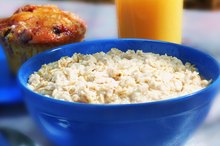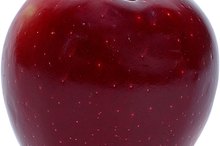What does fact checked mean?
At Healthfully, we strive to deliver objective content that is accurate and up-to-date. Our team periodically reviews articles in order to ensure content quality. The sources cited below consist of evidence from peer-reviewed journals, prominent medical organizations, academic associations, and government data.
- Harvard Medical School: Abdominal Fat and What to do About It
- Harvard Medical School: Glycemic Index and Glycemic Load for 100+ Foods
The information contained on this site is for informational purposes only, and should not be used as a substitute for the advice of a professional health care provider. Please check with the appropriate physician regarding health questions and concerns. Although we strive to deliver accurate and up-to-date information, no guarantee to that effect is made.
A Nutrition Plan for an Apple Shape
Medical professionals and dieting experts often classify body shapes using the fruit shapes of "apples" or "pears." A person with an apple-shaped figure carries and stores her weight around her abdominal area, while a person with a pear-shaped figure carries weight in the hip and thigh region, according to the U.S. Department of Health and Human Services Office on Women's Health. Higher levels of abdominal fat carry health risks that make following a healthy nutritional plan important to your long-term health.
Visceral Fat
When your body shape resembles an apple, you store fat not only directly under your skin's surface, but also deep into your stomach region, according to the Harvard Medical School 1. This visceral fat not only adds inches to your waistline, but it also affects your glucose levels, increases the risk of inflammation and can release substances such as "free fatty acids" into your portal vein. A publication from Harvard Medical School indicates that these substances can negatively affect your cholesterol levels. While it can be difficult to get rid of the fat closer to the surface of your skin, you can reduce the amount of visceral fat you carry through dedicated diet and exercise.
- When your body shape resembles an apple, you store fat not only directly under your skin's surface, but also deep into your stomach region, according to the Harvard Medical School 1.
- This visceral fat not only adds inches to your waistline, but it also affects your glucose levels, increases the risk of inflammation and can release substances such as "free fatty acids" into your portal vein.
The Basics
How to Lose Weight for an Android Body Type
Learn More
A study published in the May 2007 edition of the "Journal of the American Medical Association" studied the effect of different dietary components on overweight participants. A diet based on eating foods on the lower end of the glycemic scale helped people whose body placed them into the "apple-shaped" category lose weight more effectively than diets that were simply based on a reduced caloric and fat intake. The glycemic index measures a food's effect on your blood sugar. A food with a glycemic index of 55 or less may help you lose excess belly fat when combined with cardiovascular exercise. As a reference point, pure glucose has a glycemic index rating of 100.
- A study published in the May 2007 edition of the "Journal of the American Medical Association" studied the effect of different dietary components on overweight participants.
- A food with a glycemic index of 55 or less may help you lose excess belly fat when combined with cardiovascular exercise.
Healthy Choices
Developing a nutrition plan to reduce your waist size and amount of visceral fat can be relatively simple, as many foods that fall within this category are whole, natural foods that are readily available at most grocery stores. Avoid foods made with white or brown sugar, and use sugar substitutes in your drinks. Low-glycemic index grains include those made from corn, barley or rye. Read the label on cereals, processed foods and bread, and avoid those with added sugars. Choose low-fat dairy and protein foods to save calories and avoid unneeded saturated fats. Eat mainly non-starchy vegetables and limit the number of times each week you have peas or potatoes. Dried fruits contain higher concentrations of sugar, so choose natural fruits, such as citrus fruits, grapes, pears or peaches.
- Developing a nutrition plan to reduce your waist size and amount of visceral fat can be relatively simple, as many foods that fall within this category are whole, natural foods that are readily available at most grocery stores.
- Avoid foods made with white or brown sugar, and use sugar substitutes in your drinks.
Sample Day
Foods to Avoid with an Apple Shape
Learn More
A typical day of eating in an attempt to reduce the "apple-shape" appearance of your body may start with a slice of rye or pumpernickel bread spread with 1 teaspoon of natural peanut butter. Other appropriate breakfast choices include bran cereal with skim milk, and an apple or orange. Lunch foods can include spinach wraps, black beans and converted white rice, and raw spinach. Add a cup of fat-free or reduced-fat yogurt and a piece of fruit to your lunch. More protein choices include lean seafood or poultry. Avoid meats with breading, as the breading increases the glycemic index of the meat. For dinner, have a large salad with fat-free dressing, a lean protein choice, a small serving of a whole grain, such as:
- rice or a roll,
- 1 1/2 cups of steamed vegetables
- A typical day of eating in an attempt to reduce the "apple-shape" appearance of your body may start with a slice of rye or pumpernickel bread spread with 1 teaspoon of natural peanut butter.
- For dinner, have a large salad with fat-free dressing, a lean protein choice, a small serving of a whole grain, such as: * rice or a roll,
* 1 1/2 cups of steamed vegetables
Related Articles
References
- Harvard Medical School: Abdominal Fat and What to do About It
- Harvard Medical School: Glycemic Index and Glycemic Load for 100+ Foods
- Ojo O, Ojo OO, Adebowale F, Wang XH. The effect of dietary glycaemic index on glycaemia in patients with type 2 diabetes: A systematic review and meta-analysis of randomized controlled trials. Nutrients. 2018;10(3):373. Published 2018 Mar 19. doi:10.3390/nu10030373
- Glycemic Index and Diabetes. American Diabetes Association
- Search for the Glycemic Index. The University of Sydney
- Zeevi D, Korem T, Zmora N, et al. Personalized Nutrition by Prediction of Glycemic Responses. Cell. 2015;163(5):1079-1094. doi:10.1016/j.cell.2015.11.001+
- Sacks FM, Carey VJ, Anderson CA, et al. Effects of high vs low glycemic index of dietary carbohydrate on cardiovascular disease risk factors and insulin sensitivity: the OmniCarb randomized clinical trial. JAMA. 2014;312(23):2531-41. doi:10.1001/jama.2014.16658.
- Vega-lópez S, Venn BJ, Slavin JL. Relevance of the Glycemic Index and Glycemic Load for Body Weight, Diabetes, and Cardiovascular Disease. Nutrients. 2018;10(10). doi:10.3390/nu10101361
- Glycemic Index Database. University of Sydney. Updated October 13, 2020
- Eleazu C. O. (2016). The concept of low glycemic index and glycemic load foods as panacea for type 2 diabetes mellitus; prospects, challenges and solutions. African health sciences, 16(2), 468–479. doi:10.4314/ahs.v16i2.15
- Foster-Powell, Kaye, Holt, Susanna and Brand-Miller, Janette. "International table of glycemic index and glycemic load values: 2002." American Journal of Clinical Nutrition. 76,:1: 5-56 (2002).
- International Carbohydrate Quality Consortium, Jenkins, D. J., Willett, W. C., Astrup, A., Augustin, L. S., Baer-Sinnott, S., … Wolever, T. M. (2014). Glycaemic index: did Health Canada get it wrong? Position from the International Carbohydrate Quality Consortium (ICQC). The British journal of nutrition, 111(2), 380–382. doi:10.1017/S0007114513003905
- Leroux, MarcusFoster-Powell, Kaye, Holt, Susanna and Brand-Miller, Janette. "International Table of Glycemic Index and Glycemic Load Values: 2002." American Journal of Clinical Nutrition. Vol. 76, No. 1, 5-56, (2002).
- Lui, S., Willett, WC, et al. "A prospective study of dietary glycemic load, carbohydrate intake, and risk of coronary heart disease in US women.." American Journal of Clinical Nutrition. 71(6):1455-61. (2001).
- Mayer-Davis, E.J., Dhawan, A et al. "Towards understanding of glycaemic index and glycaemic load in habitual diet: associations with measures of glycaemia in the Insulin Resistance Atherosclerosis Study.." British Nutrition Journal. 95(2):397-405. (2006).
- Sacks, F. M., Carey, V. J., Anderson, C. A., Miller, E. R., 3rd, Copeland, T., Charleston, J., … Appel, L. J. (2014). Effects of high vs low glycemic index of dietary carbohydrate on cardiovascular disease risk factors and insulin sensitivity: the OmniCarb randomized clinical trial. JAMA, 312(23), 2531–2541. doi:10.1001/jama.2014.16658
- Salmeron, J, Manson, JE, et al. "Dietary fiber, glycemic load, and risk of non-insulin-dependent diabetes mellitus in women.." Journal of the American Medical Association. 12;277(6):472-7. (1997).
- Vega-López, S., Venn, B., & Slavin, J. (2018). Relevance of the Glycemic Index and Glycemic Load for Body Weight, Diabetes, and Cardiovascular Disease. Nutrients, 10(10), 1361. doi:10.3390/nu10101361
- Zeevi, D. Korem N. et al. Personalized Nutrition by Prediction of Glycemic ResponsesCell. 163:(5):1079-94. November 2015.
Writer Bio
Diane Lynn began writing in 1998 as a guest columnist for the "Tallahassee Democrat." After losing 158 pounds, she wrote her own weight-loss curriculum and now teaches classes on diet and fitness. Lynn also writes for The Oz Blog and her own blog, Fit to the Finish. She has a Bachelor of Science in finance from Florida State University.









